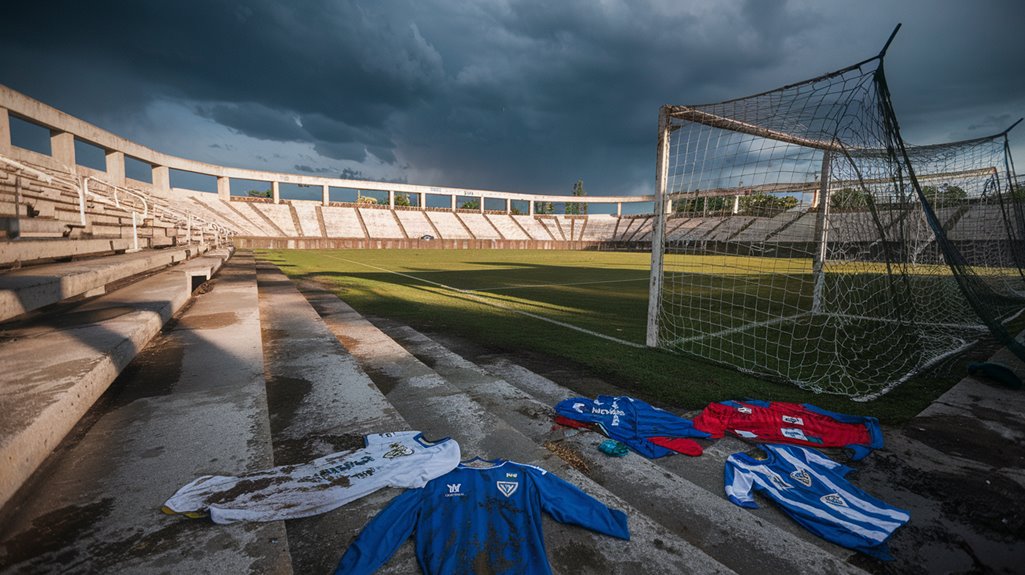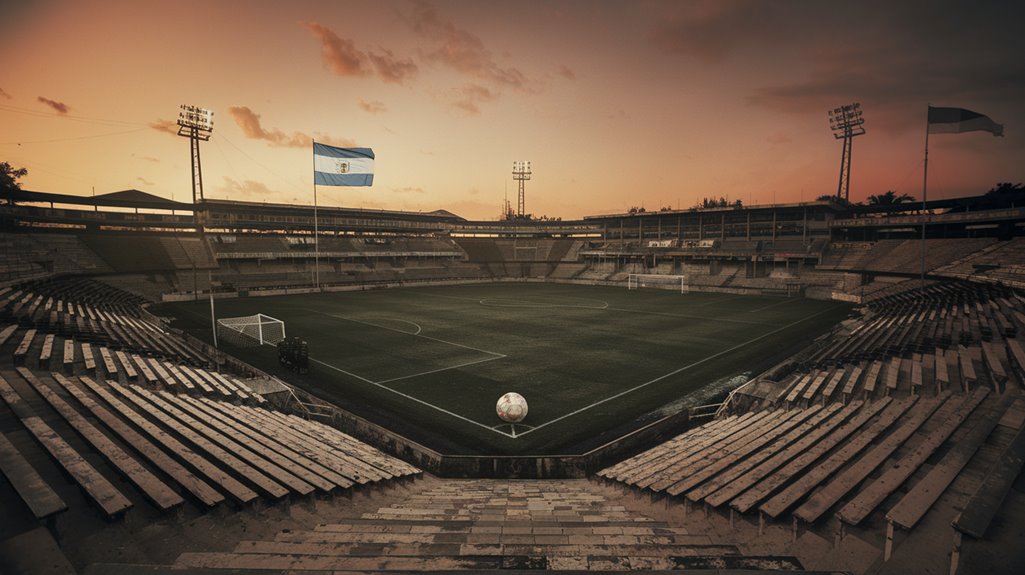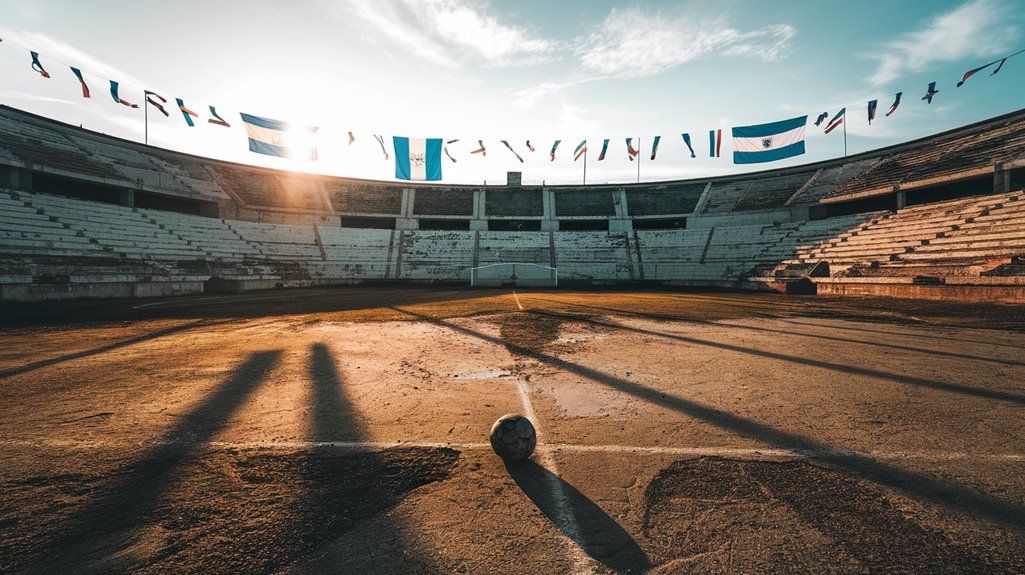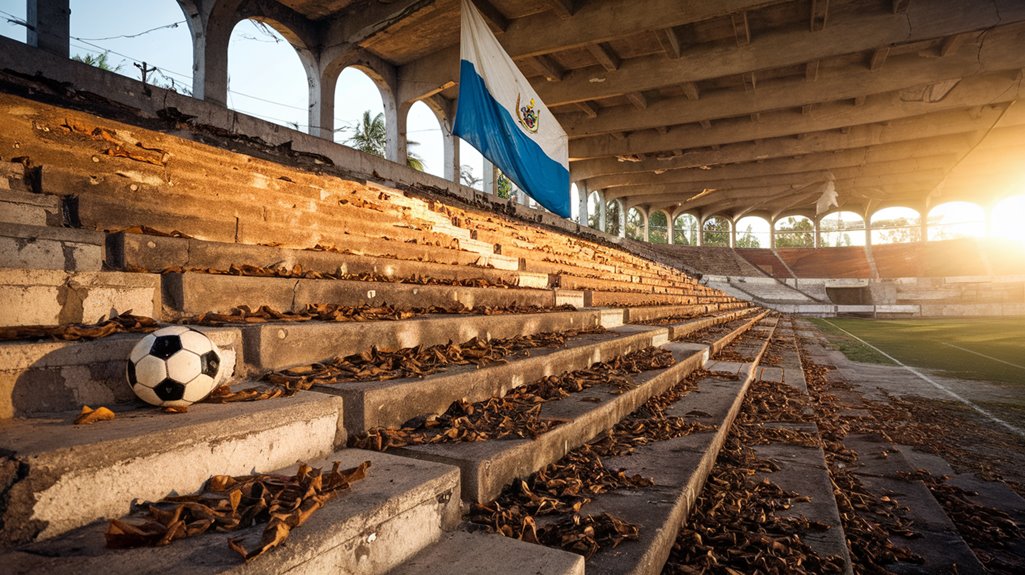The Football Feud That Sparked a Real-Life War
Like a match dropped into a barrel of gunpowder, a single soccer qualifier in 1969 ignited one of history's most unusual conflicts. You've probably heard of wars starting over territory, resources, or ideology – but a sports match? That's exactly what happened between Honduras and El Salvador, when rising tensions erupted after their World Cup qualifying games. What began with soccer chants and referee disputes quickly spiraled into a full-scale military conflict, leaving you to wonder how a simple game could trigger such devastating consequences.
The Match That Lit the Powder Keg

While football matches often stir passionate rivalries, the 1969 World Cup qualifier between Honduras and El Salvador sparked something far more sinister. What began as a football rivalry quickly morphed into a dangerous display of nationalism and hatred.
On June 8, 1969, in Tegucigalpa, the historical context of regional tensions boiled over when Honduran fans surrounded the Salvadorean team's hotel, pelting it with stones and creating a cacophony of car horns to deprive players of sleep. Just as conflict in storytelling shapes powerful narratives, this match revealed how sports can ignite deep-seated societal tensions. The match was crucial as it could determine which team would qualify for 1970 World Cup.
Honduras's last-minute 1-0 victory triggered devastating consequences when a young Salvadorean woman, Amelia Bolanios, took her own life in despair. Her funeral became a political spectacle as El Salvador's president and national team attended, transforming a sporting defeat into a powerful symbol of national humiliation.
When Stadium Riots Turned to Military Action
As tensions reached their breaking point in 1969, stadium violence between Honduras and El Salvador erupted into full-scale military conflict. What started as fan violence quickly spiraled beyond stadium security's control, leading to unprecedented conflict escalation.
The transformation from sports rivalry to warfare followed these critical developments:
- Initial stadium riots overwhelmed local police, exposing deep-rooted political unrest between the two nations.
- Security failures allowed weapons to enter stadiums, mirroring the dangerous pattern seen in incidents like Port Said.
- Military forces began mobilizing as authorities failed to contain the spreading violence. Research techniques proved essential in documenting the rapid escalation of events.
Similar to Egypt's Port Said tragedy where 74 people died during a football match, this case demonstrates how quickly sporting events can turn deadly when security measures break down. While most football rivalries stay on the pitch, this case shows how quickly things can escalate when political powder kegs meet sports-related turmoil.
The Human Cost of a Sports Rivalry
Beyond the stadium walls and media headlines, the human toll of sports rivalries manifests in disturbing statistics and psychological trauma.
You'll find that nearly 40% of NFL fans have witnessed crimes at stadiums, while 7.2% have become victims themselves, facing everything from verbal abuse to physical assault. Individual thrill-seeking often drives fans to engage in destructive behavior that they wouldn't consider in other settings.
Research shows that rivalry dyad scores can predict the intensity of antagonistic behaviors between opposing fan bases.
The emotional turmoil doesn't end with the game's final whistle.
When you consider how fan violence escalates during high-stakes matches and local derbies, you'll understand why these rivalries cut deeper than sport.
Geographic proximity between teams intensifies the perceived threats, while socioeconomic differences fuel the antagonism.
As modern society's pressure valve, football allows you to release pent-up emotions – but this release often comes at a devastating personal cost, transforming ordinary fans into both perpetrators and victims.
Beyond the Game: Deep-Rooted Tensions
The roots of football rivalries extend far beneath the surface of game-day violence and stadium incidents. What you're witnessing on the pitch often reflects decades, even centuries, of deep-rooted tensions between communities, regions, and nations.
The cultural significance of these matchups transcends sport, carrying the weight of historical disputes and societal divisions. Recent conference realignment trends threaten to dismantle these cherished traditional matchups that have defined college football for generations. The passionate fans transform stadiums into cauldrons of noise during these intense rivalry matches.
Consider these fundamental layers that fuel football's fiercest rivalries:
- Historical conflicts, like the War of Toledo that sparked Ohio State-Michigan's intense rivalry
- Geographic proximity that creates natural competition and emotional investment, as seen in the FSU-UF rivalry
- Cultural identity clashes, exemplified by El Clásico's embodiment of Spanish regional politics
You'll find these underlying tensions don't just influence the matches – they shape entire communities' identities and values, making each derby more than just a game.
Legacy and Lessons From a Tragic Conflict

When propaganda and nationalism collide with sports, you'll find few examples more stark than the Football War's devastating aftermath. The conflict's propaganda effectiveness ran deep, exploiting football's inherent nationalism and turning athletic rivalry into military confrontation.
The three World Cup matches became the spark that ignited decades of underlying tensions between the two nations into open warfare.
Similar to Civil War soldiers who formed deep emotional bonds after combat trauma, veterans of this conflict sought solace in their shared experiences.
You can still see its lasting scars in Central America's fractured economic relationships and unresolved border tensions.
Beyond the immediate casualties, the war inflicted profound emotional trauma that echoed through generations. It demonstrated how media manipulation and nationalist fervor can transform sporting events into catalysts for violence.
Today, the Football War serves as a sobering reminder that when sports become weaponized for political gains, the consequences extend far beyond the playing field, damaging regional cooperation and leaving wounds that take decades to heal.










